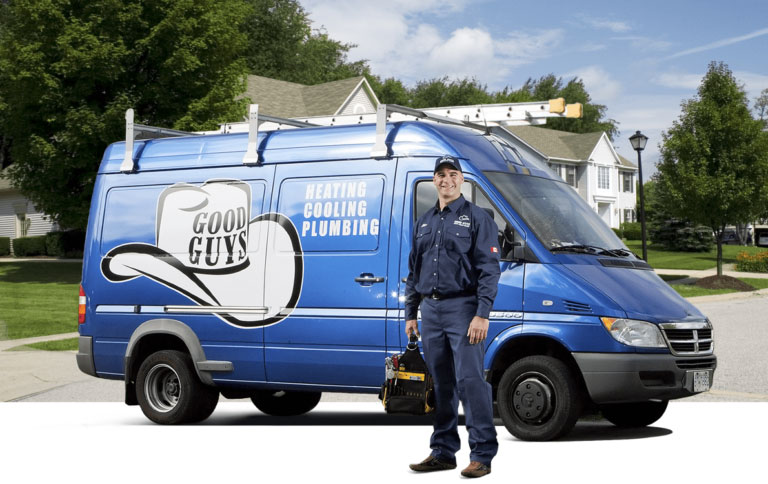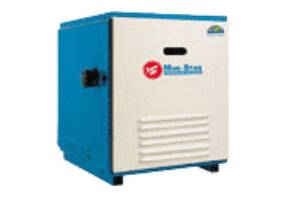Which is better: In floor radiant heating or a forced air furnace? We are often asked this question by people looking to buy a new home. Each of them has its own pros and cons.
| In floor heating | Forced air furnace | |
| Evenness of heat (floor to ceiling) | This is the main advantage of radiant heating. The heat starts underneath the floor and gradually rises towards the ceiling. This provides very even temperatures from floor to ceiling. | Single stage furnaces generate heat in short bursts (except on the very coldest days), and it quickly rises to the ceiling. The result is uneven temperatures from floor to ceiling.
New multi-stage variable speed furnaces can operate more consistently at a lower level on mild days. This results in a more even heat distribution, but still not as even as with in floor heat (in most cases). See our furnaces page to learn more. |
| Evenness of heat (room to room) | Piping is usually placed under the floor of every room. The piping in each room will be heated to the same temperature, ensuring an even distribution of heat. | Most duct systems are not very well designed, and distribute much more heat to certain areas than others (some rooms such as bathrooms might not even have registers). A variable speed furnace can constantly run its fan at a low level (while consuming very little energy) to reduce temperature fluctuations. However, many duct systems are so poorly designed that even a variable speed furnace cannot fully solve the problem. |
| Evenness of heat (over time) | The system provides heat more gradually than a standard furnace, keeping temperatures constant over time. | On mild days, single stage furnaces deliver heat in periodic blasts. This results in uneven temperatures over time.
Multi-stage variable speed furnaces (especially ones with variable capacity gas valves) are much better at delivering heat in a slow, consistent manner. |
| Energy costs | Typically, a home’s occupants spend most of their time sitting or lying down. This means they will adjust their thermostats to ensure a comfortable temperature closer to the floor. Thus, having a system that provides more even temperatures may slightly reduce energy costs. Zoning can also save energy (see below). However, programmable thermostats are rarely used due to the longer recovery time (see below), and this can raise energy costs. | Since heat tends to collect near the ceiling, occupants may feel cool when sitting or lying down, and raise the thermostat temperature. This may result in slightly higher energy costs. |
| Maintenance costs | Substantially higher. In addition to the boiler itself, the “water side” components must also be maintained. These include pumps, air vents, zone valves, tempering valves, and other components. Some of these components are not very reliable. Plus, the system should be flushed periodically.
There is also the potential of a leak occurring under the floor. This is fairly rare, but can be very expensive. |
Furnaces are generally less expensive to maintain. Annual maintenance is recommended, but replacement of parts is not required as often. |
| System replacement costs | Substantially higher. Replacing a boiler and all of the water side components can take up to 5 days. Also, if the system has polybutylene piping, a boiler with a stainless steel or copper heat exchanger will be required, and these are more expensive. (See our boilers page to learn more about boiler replacement options.) | Less expensive than a boiler. A new furnace can usually be installed in 1 day. However, in some homes, the new high efficiency furnaces can be very difficult (and expensive) to install. |
| Zoning | Almost all radiant heating systems include multiple zones. This means the home is divided into different areas, each with its own thermostat, and each area can be heated to a different temperature. | Few forced air systems are zoned. To add zoning, many dampers (motorized valves) and an advanced control system must be installed. This is a complex and expensive task. |
| Recovery time (how long it takes the system to heat a cold room) | Heat is delivered more gradually, as it takes time for the system to heat the water. It may take hours to heat up a cold room, so many homeowners just leave the system on 24/7. | Depends on the size of the furnace and its operation, but is generally much faster than with in floor heating. |
| Air conditioning/ IAQ | In floor heating systems are not made to carry cold water. An air conditioning unit cannot be hooked up to an existing in-floor system, so a separate air conditioner (usually a ductless split system) must be installed in each room. This is very expensive.
Also, an air filtration system cannot be hooked up to a hydronic system. A separate ducting system must be installed or portable air cleaners must be added to each room. |
An air conditioner can be hooked up to the furnace and use the existing ductwork.
Air filtration systems can also be added to clean the air that passes through the furnace. |
What about baseboard heating?
Hot water baseboard heating systems offer most of the disadvantages of radiant heating systems with less of the benefits. They are almost as expensive to maintain as a radiant system, they have long recovery times, they don’t provide the same evenness of heat that radiant systems do (although they still provide a more even heat than some forced air systems), and air conditioning cannot be added to the existing distribution system. Plus, the baseboards can restrict where furniture is placed.
But baseboard systems do usually include zoning, and some homeowners feel they provide a more “cozy” and “comfortable” heat than forced air furnaces do.
Learn more about new furnaces on our furnaces page.
Learn more about new boilers on our boilers page.
To schedule a free quote on a new furnace or boiler, call 604 GOOD GUY (604 466-3489) or visit our Schedule Quote page.



